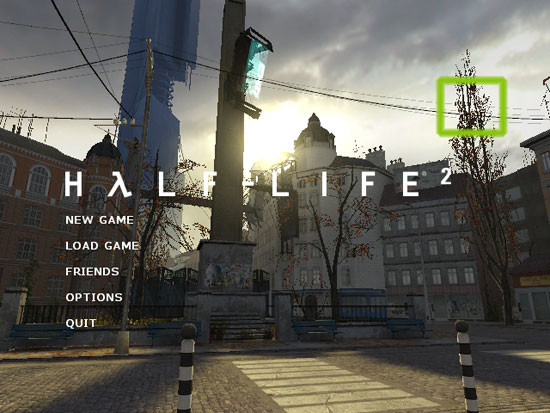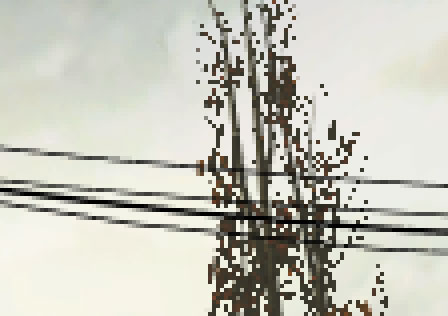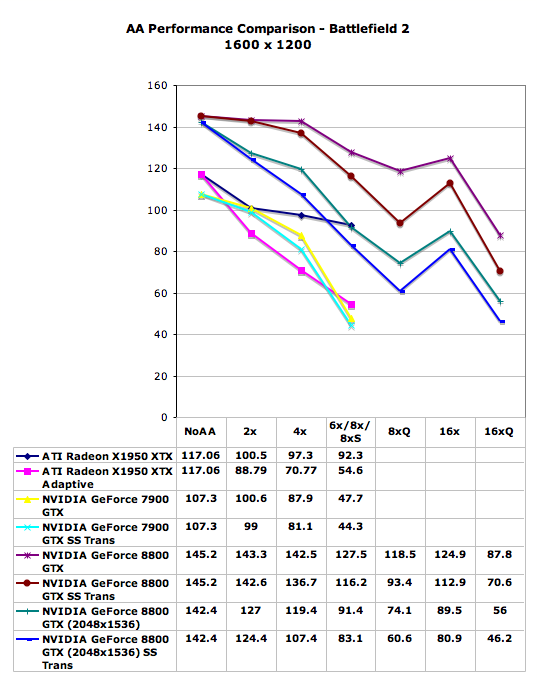NVIDIA's GeForce 8800 (G80): GPUs Re-architected for DirectX 10
by Anand Lal Shimpi & Derek Wilson on November 8, 2006 6:01 PM EST- Posted in
- GPUs
What's Transparency AA?
Transparency AA is NVIDIA's method of applying AA to transparent textures. Because MSAA only looks at one texture sample per pixel per polygon where more than one polygon slices a pixel area, it is not able to smooth jagged edges in transparent textures. In order to combat this, NVIDIA applies supersample AA to transparent textures. Their multisample transparency AA really doesn't do much for visual quality, so we will be ignoring it today. It only allows multisample through transparent texture areas and not of the texture itself.
Supersample AA performs a texture lookup at each sub-pixel to determine how much of the pixel falls on a transparent area of the texture and how much falls on an opaque area. The analog in ATI hardware is called Adaptive AA, which does basically the same thing. This generally has a very large performance impact for 3D scenes with many transparent textures (fence, bushes, leaves, and the like).
All screenshots on this page are 400% zooms of the highlighted portion of the following Half Life 2 screenshot:

Here's a look at Half-Life 2 with and without Transparency AA. We can clearly see how the leaves of the trees get smoothed out and look much better.

G80 No Transparency G80 Transparency AA
Hold mouse over links to see Image Quality
When comparing G70, G80, and R580, we have to remember that for NVIDIA hardware we've disabled gamma correct AA. It isn't possible to do this on ATI hardware, and thus we have a comparison of gamma correct AA on transparent textures as well.

G70 4X No Gamma G80 4X No Gamma ATI 4X Gamma
Hold mouse over links to see Image Quality
G70 and G80 don't look that different, but the R580 creates a kind of mushy look around the trees. This is another side effect of gamma correct AA and its potential negative impact on image quality. Worse examples include wire mesh or fences built with transparent textures: gamma correct AA can end up making parts of a fence disappear. Ideally, if we could apply gamma correct AA to high contrast edges and disable it for everything else, we'd see an image quality improvement. But the downsides just keep piling up with thin lines and transparent textures causing problems for gamma correction.
While transparency AA does enhance image quality a good deal, we do need to consider the performance impact. We'll revisit our antialiasing scaling graph from our CSAA page with Transparency and Adaptive AA enabled.

With G80, we see great performance at high resolution with high levels of AA while Transparency AA is enabled. With this level of performance, as long as R600 is able to keep up, we would love to check the Transparency AA check box every time we test with AA. For now, the performance degradation in R580 is just too high to justify at resolutions over 1600x1200 in most cases. An increase in resolution to a comparable performance level will net a higher gain in image quality.










111 Comments
View All Comments
yyrkoon - Thursday, November 9, 2006 - link
If you're using Firefox, get, and install the extension "flashblock". Just did this myself today, tired of all the *animated* adds bothering me while reading articles.Sorry AT guys, but we've had this discussion before, and its realy annoying.
JarredWalton - Thursday, November 9, 2006 - link
Do you want to be able for us to continue as a site? Because ads support us. Anyway, his problem is related to not seeing images, so your comment about blocking ads via flashblock is completely off topic.yyrkoon - Thursday, November 9, 2006 - link
Of course I want you guys to continue on as a site, just wish it were possible without annoying flashing adds in a section where I'm trying to concentrate on the article.As for the off topic part, yeah, my bad, I mis-read the full post (bad habit). Feel free to edit or remove that post of mine :)
archcommus - Thursday, November 9, 2006 - link
What browser are you using?falc0ne - Thursday, November 9, 2006 - link
firefox 2.0JarredWalton - Thursday, November 9, 2006 - link
If Firefox, I know there's an option to block images not on the originating website. In this case, images come from image.anandtech.com while the article is on www.anandtech.com, so that my be the cause of your problems. IE7 and other browsers might have something similar, though I haven't ever looked. Other than that, perhaps some firewall or ad blocking software is to blame - it might be getting false positives?archcommus - Thursday, November 9, 2006 - link
Wow to Anandtech - another amazing, incredibly in-depth article. It is so obvious this site is run by dedicated professionals who have degrees in these fields versus most other review sites where the authors just take pictures of the product and run some benches. Articles like this keep the AT reader base very very strong.Also wow to the G80, obviously an amazing card. My question, is 450W the PSU requirement for the GTX only or for both the GTX and GTS? I ask because I currently have a 400W PSU and am wondering if it will be sufficient for next-gen DX10 class hardware, and I know I would not be buying the highest model card. I also only have one HDD and one optical drive in my system.
Yet another wow goes out to the R&D monetary investment - $475 million! It's amazing that that amount is even acceptable to nVidia, I can't believe the sales of such a high end, enthusiast-targeted card are great enough to warrant that.
JarredWalton - Thursday, November 9, 2006 - link
Sales of the lower end parts which will be based off G80 are what make it worthwhile, I would guess. As for PSU, I think that 450W is for the GTX, and more is probably a safe bet (550W would be in line with a high-end system these days, although 400W ought to suffice if it's a good quality 400W). You can see that the GTX tops out at just under 300W average system power draw with an X6800, so if you use an E6600 and don't overclock, a decent 400W ought to work. The GTX tops out around 260W average with the X6800, so theoretically even a decent 350W will work fine. Just remember to upgrade the PSU if you ever add other components.photoguy99 - Thursday, November 9, 2006 - link
I just wanted to second that thought -AT articles have incredible quality and depth at this point - you guys are doing great work.
It's actually getting embarrasing for some of your competing sites, I browsed the Tom's article and it had so much fluff and retread I had to stop.
Please don't forget the effort is noticed and appreciated.
shabby - Wednesday, November 8, 2006 - link
It wasnt mentioned in the review, but whats the purpose of the 2nd sli connector?